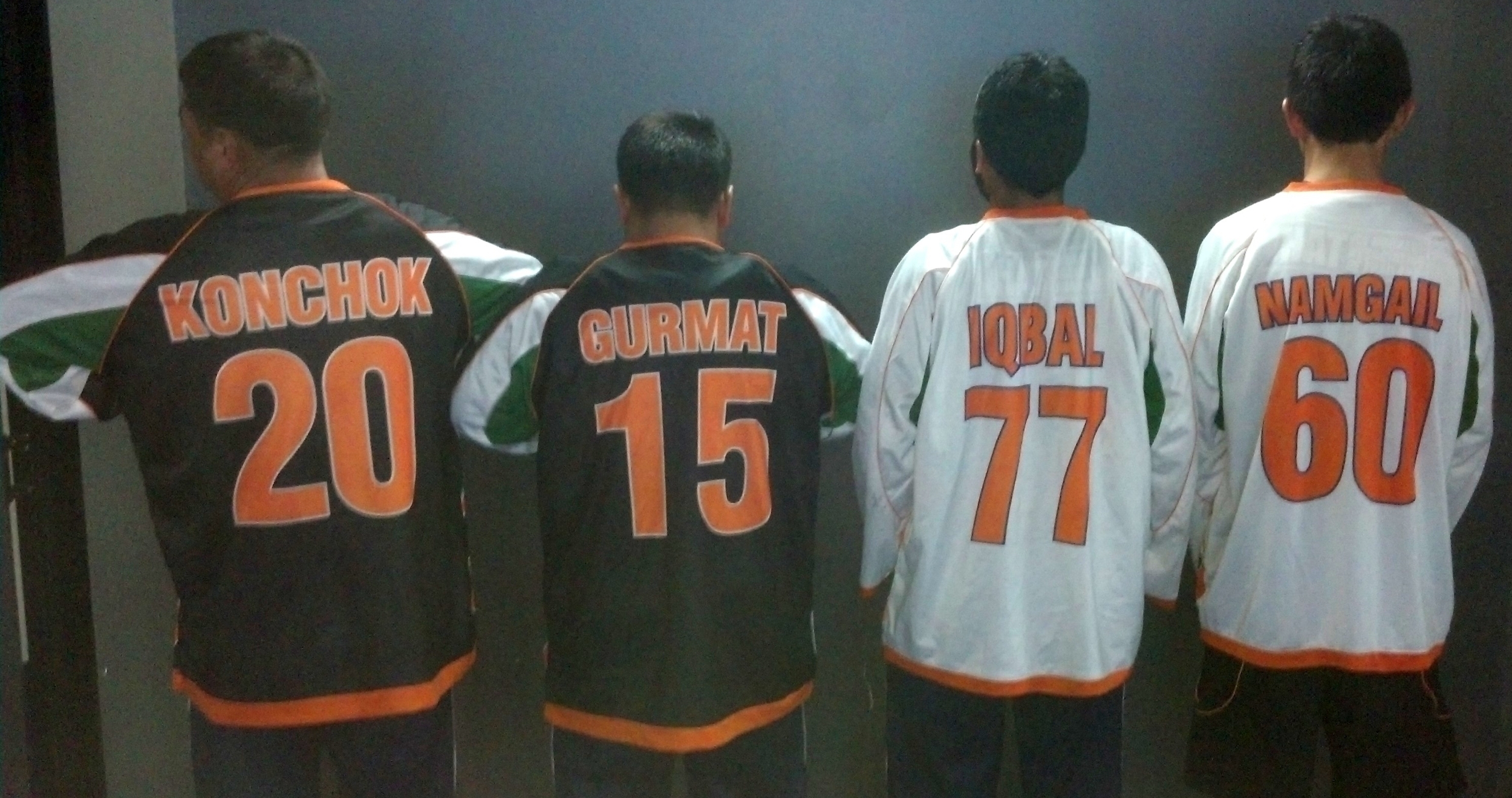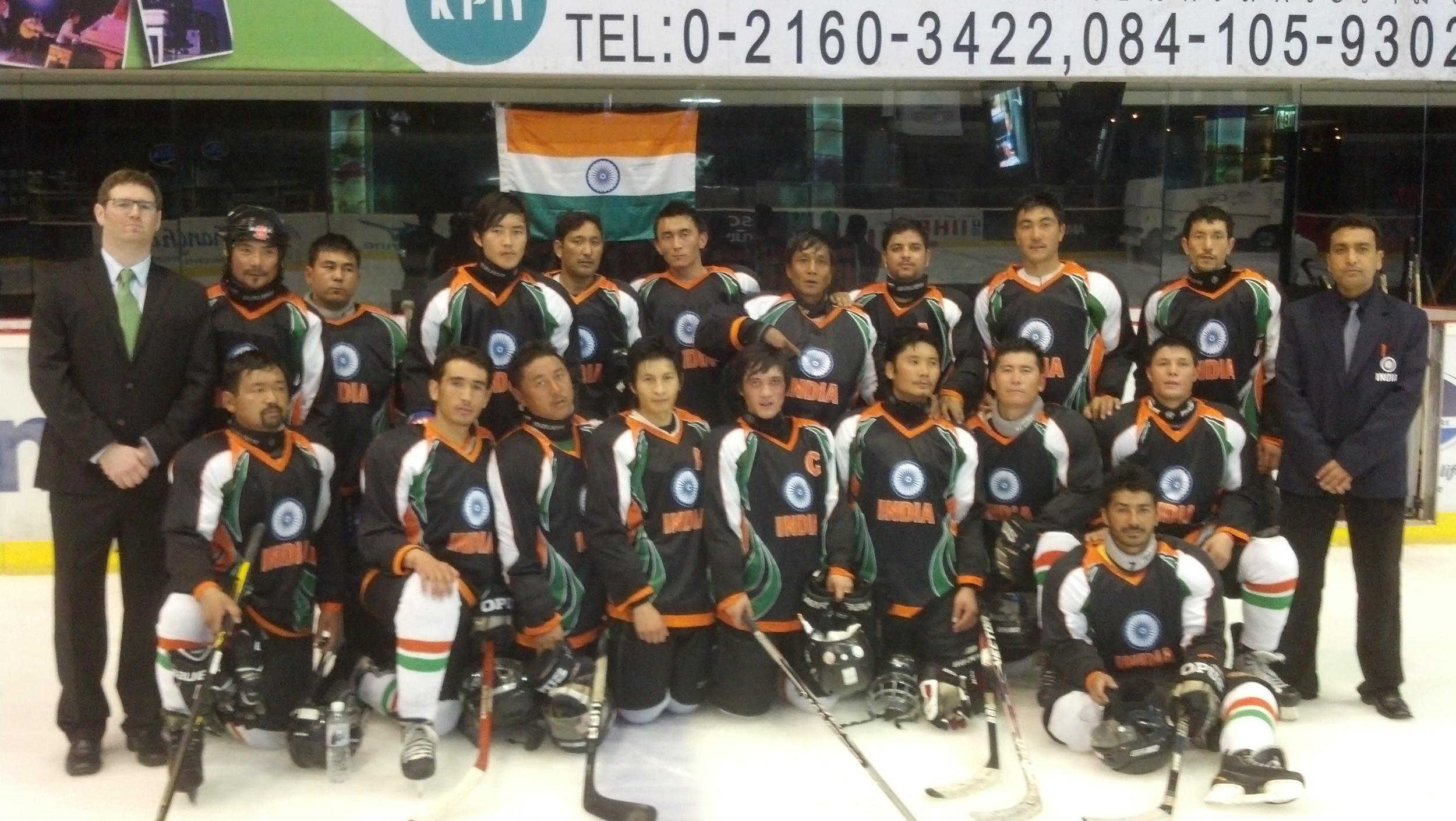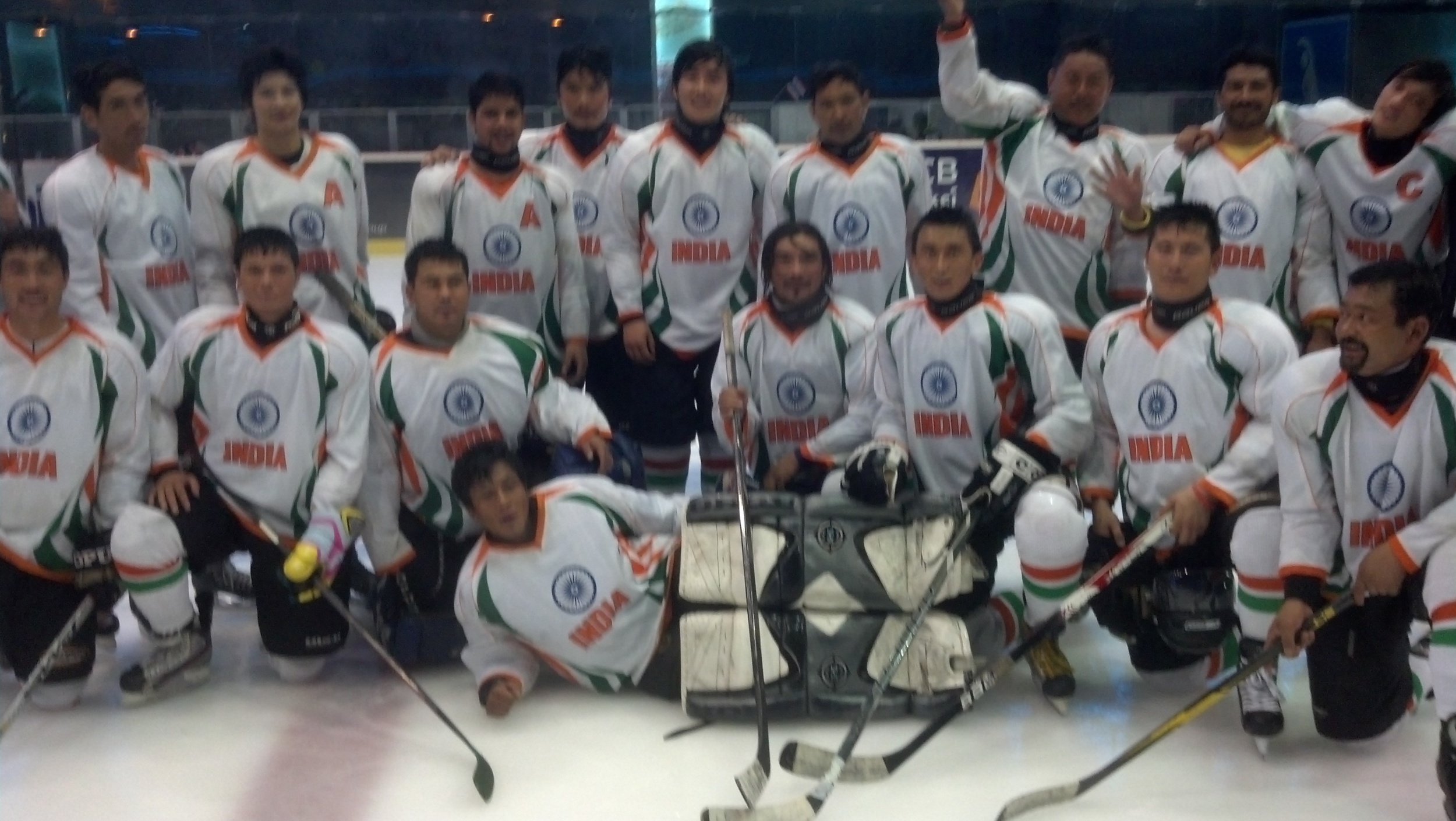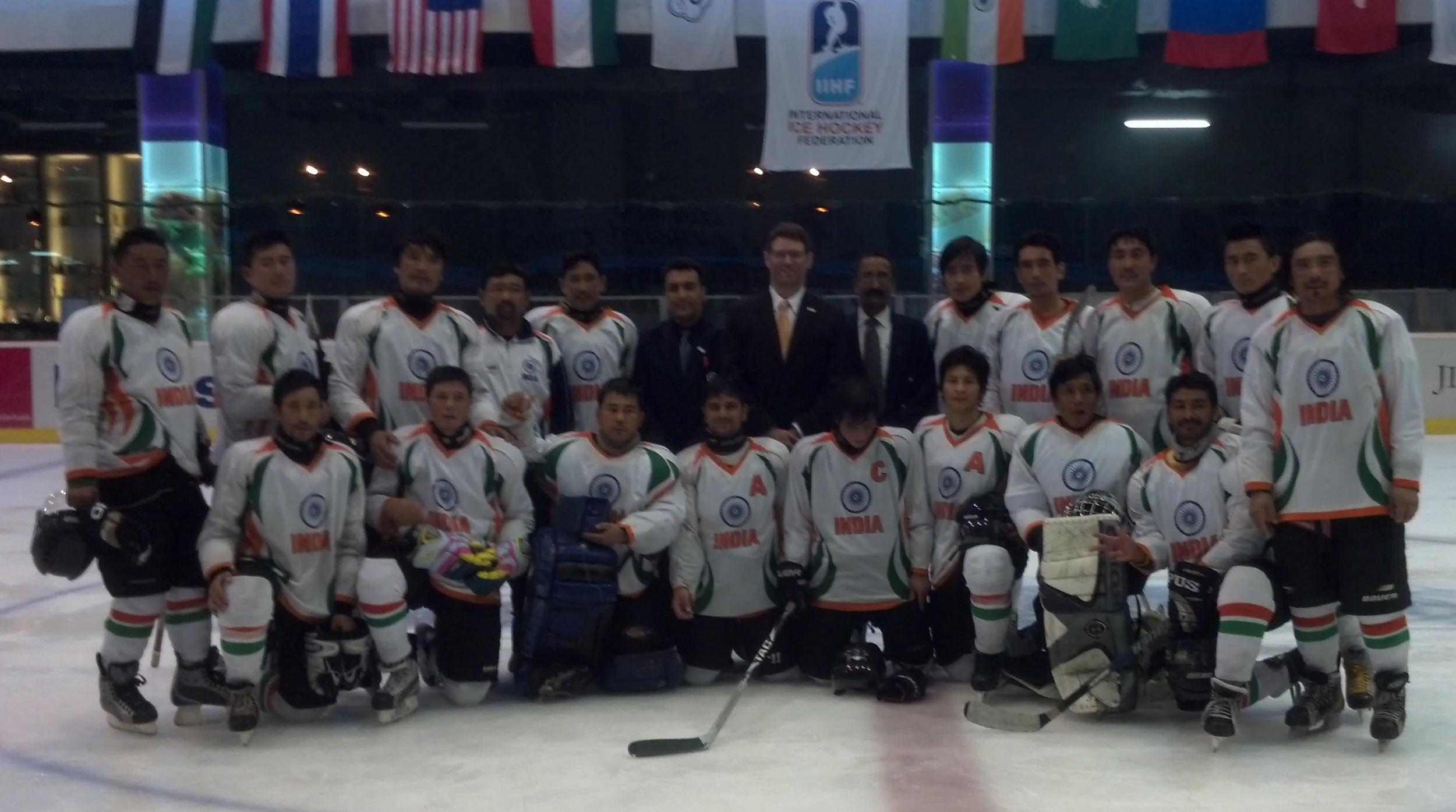This video was the culmination of many laborious hours (aka weeks) combing through months (aka years) of footage since my initial trip to the Himalayas in 2009. My incredible team at The Hockey Foundation wanted to make sure we did things right before we were finally ready to share what we consider a very special video.
"How Hockey Helps" is the product of 7+ years supporting ice hockey in...
Indian National Ice Hockey Team: How it's Relevant
First Indian National Ice Hockey Team, New Delhi, 2009
You may or may not be aware that along with being the founder, Head Coach and Executive Director of The Hockey Foundation, I'm also the Head Coach of the Indian national ice hockey team. Yes...that's right...India has an ice hockey team.
Let's get a few things out of the way here...
While on the surface it may appear to be similar, no, it's not like Jamaican Bobsled (as depicted in the movie "Cool Runnings". Whereas in Jamaica it was a group of men who trained for the Olympics in the US for a sport very much unfamiliar to their nation, in India, ice hockey has been around for about 100 years in the mountainous regions where the game can actually be played outdoors, and we do not compete at a level even close to the Olympics. In fact, we're one of the lowest ranked teams in the world, and that's OK.
The players on my team are comprised of military and civilians. They're respectful, hard-working, absolutely love ice hockey, and come from limited means. Many do not own the equipment that they use, often borrowing from their friends that do not get the opportunity to represent their country in the IIHF Challenge Cup of Asia, a developmental tournament for low/un-ranked Asian hockey nations. Due to the lack of popularity and support for ice hockey in India at large (it's immensely popular in Ladakh, where 90+% of ice hockey in India takes place), the players have to pay their own way in order to play. It's an unfortunate reality. Until the team can garner some sponsors and/or government support (unlikely, considering the significant preference for cricket in India) the players will be expected to pay for themselves, which many can't do, ultimately creating a financial burden on their family and reducing the pool of players available to play for Team India.
It became clear to me a few years ago that coaching the Indian team is not an objective or of The Hockey Foundation, nor is it relevant to the mission. By no means does that diminish the importance I place on having the responsibility to select, train and coach those players. I am honored to have the opportunity to be the head coach of a national team, no matter our performance, and I care deeply for the success of the program and the players, coaches and officials that have been a part of it.
Recently though, it's become clearer how The Hockey Foundation could and should support the Indian national ice hockey team. Prior to and during last year's Challenge Cup of Asia, I had multiple budget meetings with the team, first as the bearer of bad news when I announced how much each player would be expected to contribute, then as the cheerleader, writing and sending letters to local officials to solicit support for their local athletes, then as banker, collecting funds, then again as the bearer of bad news, telling the players that they owe more money due to a handful of avoidable circumstances, and finally as possible ameliorator, coming up with some solution that could potentially help players reduce/recoup costs. This is where The Hockey Foundation comes in...
First, I thought about all of the jerseys being worn by the players. These jerseys would most likely sit in a room for 8 months before being worn again in the following winter by those players that got to wear their nation's colors. But couldn't those jerseys be more beneficial if sold to collectors and/or supporters? Not only would someone be able to acquire a truly rare and collectible piece of hockey memorabilia, but the proceeds would be divided between the players themselves and The Hockey Foundation, as facilitator and mediator in the process. Many of the players wanted to retain some of their jerseys, so I was able to ensure that every player received another set of new jerseys upon their return to India from the Challenge Cup of Asia, which was hosted in Bangkok in March, 2013. Everyone got to retain their memento for playing on Team India, and we all agreed that this was a great way to make back some of their significant financial burden.







But for those that can't afford a game-worn jersey, the Ice Hockey Association of India was able to have a handful of official Team India jerseys made before my departure from Delhi, with proceeds supporting The Hockey Foundation as a unique fundraising memento.
BOTH OF THESE JERSEYS ARE AVAILABLE FOR PURCHASE HERE
A new plan of action for this upcoming season is to be proactive in the team's fundraising efforts. To date, every player that has played on the Indian national ice hockey team is either from or lives in Ladakh. They are a part of the community that The Hockey Foundation supports in our programming, and many have participated in our coaching clinics. This year, all players have been notified, well in advance, of the expectations placed on them, including the incentive in driving enrollment in our coaching clinics, as we collect a nominal fee for the Ice Hockey Association of India to support the national association's growth and development. The more we raise in India, the more money that can be allocated to the national team, and ultimately less is expected from each player/family. This push for Ladakhis to take ownership over their own success is a major mission of The Hockey Foundation, as Ladakh has an issue with apathy, complacency and a reliance on outsiders to keep on giving money and equipment. We've adjusted our methods for donating hockey equipment due to this realization, and have become more strategic, thoughtful, and collaborative in our distribution of equipment and the expectations associated with an organization receiving our support. It's a constant work in progress, but one I'm happy to undertake and improve.
Although being the head coach of the team is not a part of The Hockey Foundation, I believe supporting the players, the team and the association are, and that support in turn helps The Hockey Foundation. Our organization's are inextricably linked. And I wouldn't have it any other way.
PURCHASE INDIAN HOCKEY JERSEYS
Jullay!
Adam
So do two more pictures equal 2000 words?
My involvement in China through Project Hope
If you are interested in learning about my background with youth hockey development, in particular internationally, I would like to refer to you to Charles B. Wang Ice Hockey Project Hope (www.nyiprojecthope.com). I had the distinct pleasure of going to China with Angela Ruggiero (www.angelruggiero.com), 3-time Olympian for Team USA in hockey, former Apprentice (season 6) contestant, and all around amazing person. Together we visited the schools in Heilongjiang Province that we were providing hockey resources to. Here is our recap from the Project Hope website. Be sure to visit nyiprojecthope.com & browse around to get a clear understanding of how much hockey can improve a kids life! I hope after seeing some pictures and reading the messages from the kids, you will be interested in donating to my cause for kids in Ladakh to have a similar experience!
Project Hope Journal 1/22/07
By Angela and Adam
We're back from China, and after almost two weeks, what we miss the most is the hospitality. Everywhere we went (all 8 schools), we were greeted with open arms, by local and school officials, and many students that were supposed to be on winter break (but came back just to see us and spend some time on the ice). The outdoor rinks have become a center to the respective communities, and the kids in our Project Hope schools, (elementary school age) skate over 5 days a week! Their smiles on the ice made it easy to ignore that it was as cold and windy as the Great Lakes region. We took them through some basic skating and puck handling drills, and then we got into the fun, reminding everyone (including the adults standing around the rinks) that hockey, above all else, is fun.
Other than skating with the Project Hope students, we also had the opportunity to scout our prospective scholarship candidates in Harbin and Qiqihar. Twenty (about ten in each city) of the best teenage boys and girls skated their hearts out for over an hour, in an intense tryout. Not only were their hockey skills put to the test (and a fair amount of stamina testing to go along with it), but an interview was conducted in English to determine whether they were ready to study at a school for a full academic year. While their hockey skills were impressive, it was clear that everyone needed more work on English. Before anyone spends a full year in America, we'll bring over a few students for the summer in an intensive ESL program, allowing them to experience the United States first hand. The opportunity to play hockey will also be important, and the students will be able to put many hours of hard work on the ice, after they do so on paper.
In our meetings with local officials, it became clear how important Project Hope has become to the lives of so many people. In some cases, over 100 students get the opportunity to learn hockey at their school. Hockey has become a class worth academic credit, and in the best of scenarios, Project Hope hockey players have been given a clear path to success. In Qiqihar, a memo was issued on behalf of the Sports and Education Bureaus, mandating that a specific system be implemented to assist these scholar athletes any way possible. We hope that the civic governments in each area, along with the Project Hope schools, can follow suit, allowing more students the opportunity to play hockey, study English five days a week, and continue to receive the funding and support of their local governments.
Whether it was the center city of Harbin, Jiamusi and Qiqihar, or a surrounding town, each community had a unique culture. The sense of family and community dominates the social character and culture, and the group lunches and dinners gave us the opportunity to become members of the community. We spent a lot of time getting to know everyone personally (through a translator, of course), and found that while our cultures are as different as can be, there are some things that we all share in common. First, and most obvious, we're all human. Sometimes, we forget what that means, but it's important. Whether you live on Long Island or in Heilongjiang, everybody wishes to be happy and successful (culturally subjective), have a long life, and wish the same for our children. Going beyond that, we all love hockey. One of the many goals of Project Hope is to cross borders using hockey as the international language. It is a sport unlike anything in the world, requiring a whole new sense of transportation just to be able to communicate. As hockey history has proven, any team can be superior once the puck drops, as long as there is a balance of talent, discipline, structure, creativity and fun. This understanding of hockey is universal, and if it ever becomes less, it will no longer be hockey.
The success lies, though, on everyone involved in Project Hope. We will continue to build rinks and provide as much equipment as possible, but at the same time, we're requesting that anyone willing to help makes a donation or other contributions in support. There is information on the web page specifying how YOU can help.
Stay tuned for more news on Project Hope. We have an exciting future and many more plans. The next invitational is scheduled for January 17-18, 2008. ANY teams interested should fill out our form. Maybe we'll even sponsor a team to compete in China. Start working on your Chinese.
Where to start? India...for now...
The first place I am looking to teach hockey in is Ladakh, a region in the state of Jammu and Kashmir (Yes, that Kashmir!) in the Himalayas, through an organization called SECMOL (Students' Eductional and Cultural Movement of Ladakh).
Ladakh, the eastern part of Jammu and Kashmir state of India, is a high-altitude desert region, on the upper reaches of the Indus River. Until recently a somewhat isolated rural society, Ladakh has seen enormous and sudden changes since the 1960s, when the Indian government started having an impact on local life through defence activities (Ladakh shares borders with both China and Pakistan) and development activities such as schools, offices, and subsidies. The region opened to foreign tourism in 1974, and is a popular destination for trekkers as well as travellers visiting ancient Buddhist monasteries, and since 2000 domestic tourists have been coming too. It is also home to a large Tibetan community.
Ice hockey is hugely popular in Ladakh, but most kids from rural families do not get the chance to play, due to lack of skates and equipment. However, at SECMOL several dozen young people from rural villages have had the chance to skate and play ice hockey, thanks to equipment donated to SECMOL by friends around the world."






